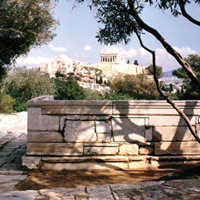
The paths by Pikionis opposite the Athens Acropolis
The International Carlo Scarpa Prize for Gardens
XIV Annual Award, 2003
The Jury of the International Carlo Scarpa Prize for Gardens has decided unanimously to award the 2003 prize, the fourteenth in the series, to the paths designed by Pikionis opposite the Athens Acropolis, the network of walkways and stopping points that stretches to the base of the Propylaia, crosses the area of St Dimitrios Loumbardiaris and rises beside the ancient walls along the slopes of the Hill of the Muses to the belvedere of the Philopappou monument.
Conceived in the 1930s and actually designed and laid out by the Greek architect Dimitris Pikionis (1887-1968) between 1954 and 1957, the paths have a grace and an intensity of authentic invention matched to the great open spaces they occupy that makes them a masterpiece of landscape art.
Once again, as happened with the prizes awarded to places that inspired the work of Costantin Brancusi, Carlo Scarpa and Jose Plecnik, the Jury has chosen to highlight one of those rare cases of cultured, far-sighted dialogue between the Greek minister Constantinos Karamanlis, who commissioned the work, and a great maestro of the twentieth century; a dialogue that created the conditions for something quite different from the rationalistic tensions of the modern age, spurred to the conservation of a “primordial alphabet” (Mircea Eliade) but for exactly that reason also capable of radical innovation.
In his Athenian paths, Pikionis has given body to his idea of universal harmony, of a pathos that sees everything in the world as related to each other and of a Number to measure, dominate and transmit them, as he forecast in A Sentimental Topography in 1935.
Thus the outlines of Attica appear in the expanded dimensions of the contemporary city, the shade of the olive groves, through which the paths thread, dialogues with the glorious light of the Acropolis, and the pebbles, the shards of terracotta, the ancient stones, all the infinite fragments of a single composition, together with their symbolical and mythological meanings relate an “unfinished aesthetic diary” in a language which is at once archaic and new.
Even the more exposed spots share this unifying pathos. The surfaces of the wider paths are carefully weighed and calibrated; every stone is set in place, every piece of concrete shuttering; every detail is painstakingly designed down to the smallest drainage channel and the grass borders edging the olive groves.
Text taken from the 2003 Carlo Scarpa Prize Statement, edited by the Jury.
